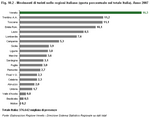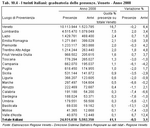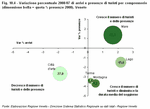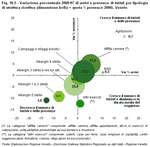10. Tourism and tourist flows
|
Veneto, which stands out for its culture of hospitality and the variety and quality of local tourism, is visited and appreciated by tourists from all over the world. Value has been added to the wide range of features provided for tourists by well-organised promotion and by the great business acumen of Veneto tour operators. The results can be seen in the fact that 14 million visitors came to Veneto in 2008, leading to over 60 million nights spent. These figures are only slightly down on 2007; this is despite the difficult economic situation and the problems seen on an international scale during the year. In fact, of all the sectors, tourism is actually considered one of the driving forces of Veneto, and it is seen as the one to focus on in order to deal with the economic crisis.
The number of tourists has remained mostly stable compared to 2007. The 0.2% decrease in the number of arrivals corresponds to a drop of around 25,000 units; this is accompanied by a moderate decline in overall presences (-0.9%), which serves to confirm the general trend for tourists to reduce the length of their holidays. It should be pointed out that, despite the fact that tourism has been affected by the international crisis, the number of tourists has actually increased constantly since 2001 (+5.4%). (Figure 10.1) and (Table 10.1) We should bear in mind, however, that these figures only include those people who spent at least one night in accommodation establishments in Veneto for various reasons (tourism, business, wellbeing or religion, etc.). None of the analyses take day-trips into account. These trips, which we shall take a look at later on, play an important role in Veneto tourism as many people are drawn to the region by events and exhibitions. Veneto has been a leading tourist region in Italy for quite a few years now, as is confirmed by the millions of tourists who choose to spend their holidays here. This position continued into 2007, the last year for which national data is available, as Veneto accounted for 14.7% of arrivals and 16.3% of nights spent in the entire country. Next on the list, with around 20 million fewer nights spent, are Trentino Alto Adige, Toscana and Emilia Romagna. (Figure 10.2)
Most tourists who come to Veneto come from abroad. In 2008, international visitors made up 58.9% of the regional tourist flow, with more than 35.5 million nights spent. Nowadays this important component of the tourism sector is being put to the test by the challenging economic situation being felt the world over. Tourism in Veneto is coping well, however, even if a little patchily. There was a very slight drop in international visitors spending nights here (-1.2%), but domestic tourism remained largely stable (-0.5%). As for numbers of tourists, however, although the number of international visitors has decreased (-2.2%), the number of Italian tourists has increased (+3.1%). Furthermore, we should also note that percentage variations are on the year 2007, which was actually a record year, and the best year we have seen in the last decade. (Figure 10.3)
In terms of traditional international visitors, the decrease in the number of German, British and Spanish visitors bring figures back in line with those of 2006, whereas the biggest drop can be seen in the number of Austrian (-7.3% nights spent compared to 2007) and American visitors in particular (-18.6%), these latter being put off by the strength of the euro against the dollar. On the other hand, a further increase was seen in the number of Dutch (+12.5%), French (+0.4%) and, most notably, Danish visitors (+16.3%), the market which shows the biggest amount of growth. At the same time, new tourist markets are emerging, with Eastern European countries in first place: the Czech Republic (+13.9%), Poland (+21.8%), Russia (+18.0%) and Slovakia (+9.6%). We can also count in the Northern European countries (Sweden +10.6% and Norway +3%) and overseas countries such as Australia (+5%) and Brazil (+19.2%). Compared to international tourism in general, Veneto has actually managed to cope fairly well and has faced fewer reductions than the rest of Italy and than its European competitors, such as France and Spain (Note 1). (Table 10.2) and (Table 10.3) As for domestic tourism, Veneto residents who take holidays within the region have always made up an important part of local tourism as their numbers are second only to German tourists. They are followed by visitors from Lombardia, whose numbers have increased by 2%; and then, but quite far behind, come visitors from Lazio and Emilia Romagna. The number of tourists from Veneto itself increased (+6.4%) in 2008, although the average length of stay decreased from 7.1 to 6.6 days in just one year. It should be pointed out that the decrease in average length of stay can be noted for all Italian visitors, except for those from Lazio, Sicilia, Liguria and Calabria, which remain unchanged. (Table 10.4)
Veneto contains so much variety it can satisfy every tourist's requirements.
Veneto's beach resorts, which alone account for 43.1% of the nights spent in the entire region, became increasingly popular with both Italian and international visitors in 2008, both in terms of arrivals (+1.7%) and of nights spent (+1.3%). The positive year for beach resorts can be seen by the increases in numbers to Bibione-Caorle, whose Local Tourist Network (Note 2) registered a 3.4% increase in nights spent, Cavallino-Treporti (+2%), Chioggia (+2%) and also Rosolina (+2.9%), whereas numbers to Jesolo-Eraclea decreased (-2.5%). The biggest groups of visitors to the beach resorts are still the Germans and local Veneto residents, each making up around 24% of nights spent. Next in line are the Austrians and visitors from Lombardia who register at around 7%. In recent years, the number of local tourists to Veneto beaches has increased much more than the number arriving from across the Alps. As a matter of fact, in 2007 the number of Veneto tourists overtook the number of German tourists, and this trend continued into 2008 (21.2% Veneto visitors compared to 19.5% Germans). Spa towns, mountain resorts, and lake resorts in particular, have seen an increase in the number of arrivals (+0.2%, +0.5% and +2.2% respectively) and, at the same time, a decrease in the number of nights spent (-3.4%, -3.7% and -1.5%), yet further proof of the trend of a reduction in the average length of holidays. In the area of Lago di Garda the high season was just as up-and-down with an increase in bookings compared with 2007 in May and July but with losses in June, August and September. Overall in 2008, 15.6% of bookings made in the whole region were made in this area. Veneto's four main groups of visitors have followed different trends: German visitors have decreased both in terms of arrivals (-3.8%) and of nights spent (-6.1%), but they still constitute the main group of visitors to the lake (33% of nights spent); British visitors continue to enjoy this type of holiday but have reduced their average length of stay; tourists from Holland and from Lombardia have increased significantly with an 11.3% and 9.3% gain in nights spent respectively. In the mountain resorts, a drop was seen in the number of nights spent during the summer season (-4.9%); more than half the tourist flows to the region occur during this season but in 2008 the weather conditions were less than favourable. The good skiing season was not able to compensate completely for this drop, but heavy snowfall meant that nights spent in February increased by 6.5% compared to the same month in 2007, and continued to increase with +7.3% in March. They then picked up again in December with +2.6%. In the spa resorts the number of Italian visitors increased (+4.2%) as the number of foreign visitors decreased (-5.9%). More visitors to the spa resorts arrived from Lombardia than from Germany, as the former increased by 4.2% and the latter dropped by 9.4%. Tourists from Emilia Romagna remained in third place (+13.5%) followed by local Veneto tourists (+9.5%). It is worth pointing out that not only did nights spent by Veneto tourists increase, but the numbers arriving did too (+3.1%). (Figure 10.4) The historic cities are the ones that have suffered the most at the hands of the troublesome economic situation as they have seen a reduction both in the number of arrivals (-1.9%) and in nights spent (-2.7%) compared to 2007. The blame for the "not terribly positive" trend in cultural tourism can be laid at the feet of international tourists as their number of arrivals decreased by 4.7% and their nights spent by 5.3%, a figure which could not even be compensated for by the significant increase in Italian visitors (+3.9% arrivals and +2.4% nights spent). Americans, who used to be the leading visitors to our historic cities, are about to lose their place at the top to the French: while the former have decreased both in number (-22.4%) and in nights spent (-19.2%), the latter have actually increased by 9.3% and 4% respectively. The numbers of British and German tourists have decreased, whereas the numbers of visitors from Lombardia and Veneto have increased. The decline in tourism to the historic cities is mainly influenced by trends in Venezia, as Venezia accounts for more than half of the nights spent in all destinations. In 2008 Venezia saw a 4% decrease in the amount of tourists. However, this area does depend significantly on international visitors, who, as we have seen, have strongly felt the effects of the economic downturn. The decrease in nights spent mostly began during the month of June, and then continued for the rest of the year. Hotels were the ones most affected by this as they provide for 85% of tourists to historic cities.
A great selling point for Veneto is its holiday accommodation; it has more than 3,200 hotels and more than 62,000 other accommodation establishments which can potentially host around 210,000 and 509,000 tourists respectively. Almost 50% of hotels have three stars and there are also a high number of one- and two-star hotels (almost 40%). Over the years the number of high-quality establishments has increased continuously, and the number of lower-quality ones has decreased.(Table 10.5)
If we look closely at the tourist flows in 2008 by type of accommodation establishment, a drop in the hotel sector stands out (-1.9% of arrivals and -4.0% of nights spent) compared to decent increases for other types of accommodation (+3.9% for arrivals and +2.0% for nights spent). The middle-low range hotels have seen the biggest losses (-9.3% of nights spent for one- and two-star hotels) and also the exclusive hotels (-10.9% for five-star hotels). The decrease in nights spent in middle range hotels was less dramatic (-4.3% for three-star hotels), whereas four-star hotels remained mostly stable with a decrease of 0.4% in nights spent compared to an increase of 0.8% in arrivals. In each type of hotel, the biggest drop was in numbers of international tourists. Other types of accommodation are becoming more attractive to visitors: more nights were spent in agrotourism establishments (+16.9%) and also in rented accommodation (+4.8%), on campsites (+1.6%) and in Bed & Breakfasts (+1.1%). The change in holiday habits is fairly evident as all types of accommodation establishments have seen a reduction in visitors' average length of stay. (Figure 10.5) |
|
Data processed by the Statistics Office of Regione Veneto are collective property; reproduction of this material is authorised for non-commercial purposes only, provided the source "Regione Veneto - Regional Statistics System Management" is acknowledged.
English translation by the University of Padova Language Centre.













